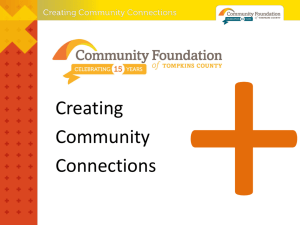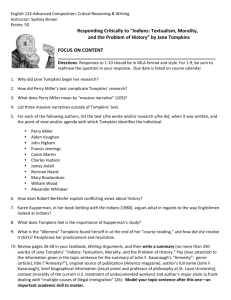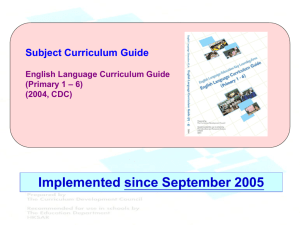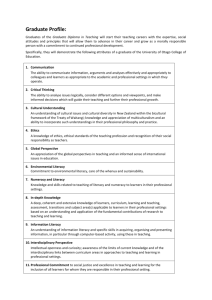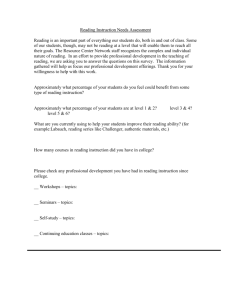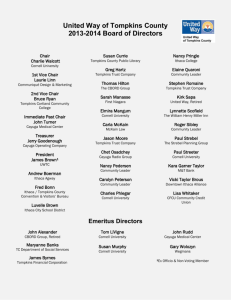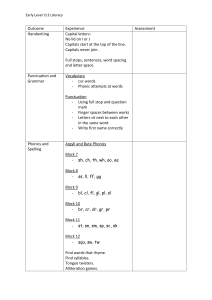Final Paper - Christal Matsumoto
advertisement
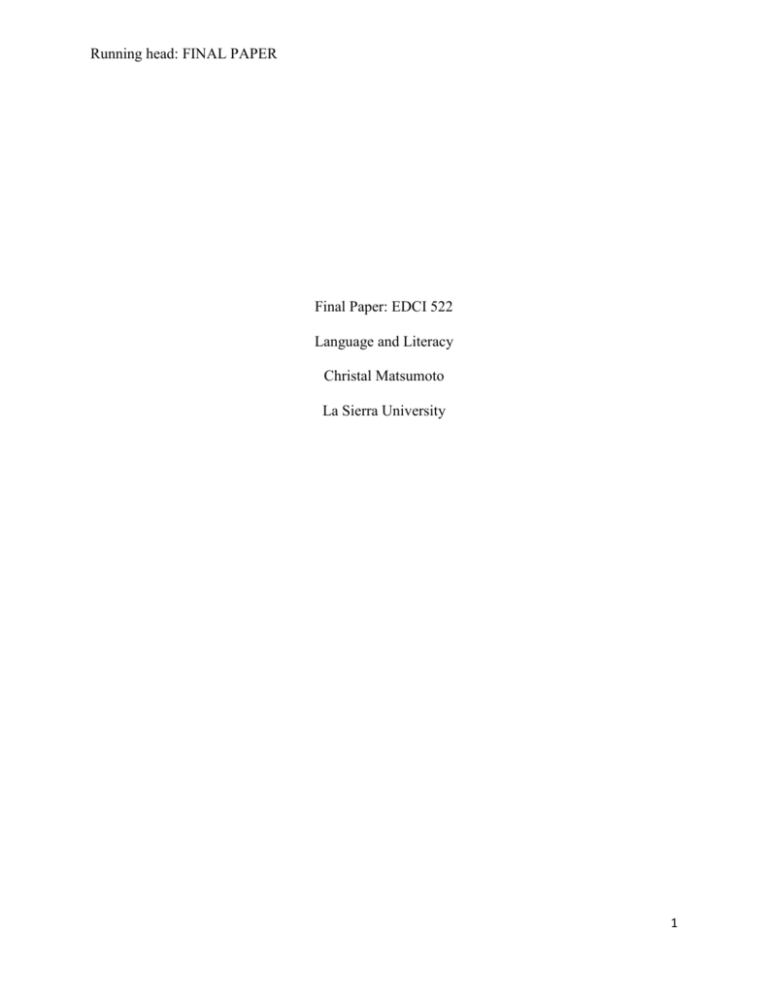
Running head: FINAL PAPER Final Paper: EDCI 522 Language and Literacy Christal Matsumoto La Sierra University 1 Running head: FINAL PAPER Living in the state of California, in which 25% or 1.4 million of its students are classified as English Learners (Hill, 2012), the need for an effective, efficient and quality language arts program and curriculum is glaringly apparent. It becomes even more essential as we come to understand that this number is an inadequate representation of the actual number of ELs in the California education system as students who transition through and out of the category are no longer accounted for in this statistic. It is no wonder California has strict requirements for each of its teachers, both in the elementary and secondary levels, which necessitate a valid California teaching credential, proof of second-language learning, and most importantly a passing score on the California Teacher of English Learners (CTEL) test and/or course work in a CTEL program (CTC, 2014). A properly trained and prepared workforce with Crosscultural, Language, and Academic Development (CLAD) certification is not merely a bonus but a must to meet the needs of California’s growing population of English learners. English language development in the education system is surrounded by controversy which mainly focuses on effective programs and instruction to adequately equip students for academic and career success. One such issue is the ongoing debate, dubbed the Reading Wars in media, over the use of Phonics versus Whole language in curriculum which has been a source of great dispute for many decades, as far back as the early 1900’s (Reyhner, 2008). Both of these theories focus on drastically different aspects of reading and have positive and negative points. Phonics is considered a “bottom up” approach (Reyhner, 2008), which prepares readers to decode text. Unfortunately, a solely phonics-based curriculum has the tendency to become overly systematic and standardized; leaving little room for student exploration of interests and lacks quality literature instead opting for the basal style of reading program with limitations. Whole language, on the other hand, is primarily concerned with “provid[ing] a literature rich 2 Running head: FINAL PAPER environment . . . combin[ing] speaking, listening, reading, and writing” (Reyhner, 2008). This becomes problematic for those students who require more extensive instruction in phonics as the whole language curriculum incorporates phonics as merely one of its units and “emphasize[s] the meaning of text over the sounds of letters” (Reyhner, 2008). In response, as far back as 1955, Rudolph Flesh wrote Why Jonny Can’t Read criticizing this one-sided approach. In my opinion, both sides of this “war” have valid points and the education system would do best to create a well-balanced curriculum in which phonics within the first formative years of language development is the principal focus without belaboring it into the higher levels of education in which students should be more attuned to their own interests and where challenging reading with more academic language is the bulk of their texts. Another issue in English language development that has been problematic for several decades is the achievement gap, found in America and internationally. The crux of the achievement gap lies chiefly in ethnicity and the excessive discord between the academic success of those of minority backgrounds and the Caucasian population, which directly effects their entry into higher levels of education, career mobility and earning potential. The difficulty experienced by English learners in their academic careers can be traced to the lack of English literacy and speaking within their homes. Although much of the achievement gap is attributed to what is termed Out of School Factors or OSF (Berliner, 2009), these can be directly correlated to English language development. The limited English exposure students receive at home affects their education insofar as their initial entry into school is as an English learner with a limited reading and spoken vocabulary and with little capable support from home. Numerous strategies have been attempted by schools and national education with varying degrees of success. This includes 3 Running head: FINAL PAPER the implementation of Ebonics (African American Vernacular English), the inclusion of English language learners in the mainstream classroom via Proposition 227 and bilingual schools. Another issue that surrounds English language development is assessment, especially in the case of EL students who may struggle with formal, standardized tests. These require a higher level of academic language to comprehend the questions which may hinder student performance in the actual subject content. According to Tompkins, when assessing a student’s language proficiency it is important to employ authentic measurements of a student’s grasp of language (2013) rather than standardized testing which targets specific language arts components while employing the writing of someone other than the student. Quality assessment should therefore focus on the student’s process of language use in all its aspects and what they produce as examples of their learning and abilities (Tompkins, 2013). This ought to include anecdotal observations or those made during guided reading groups, a more formal reading inventory, inclass writing assignments such as journaling, creative or formal writing. These Performance Task assessments are far more efficient and authentic as they assess students on their ability to perform the task rather than their ability to decipher test questions and edit the test makers’ writing. Through these kinds of assessments teachers observe the students’ grammar, syntax, semantics, vocabulary, spelling, phonics abilities, phonemic awareness, reading comprehension, etc. without requiring the students to participate in additional, time consuming and often frustrating testing. It also eliminates the problem of test anxiety which plagues students and gives inaccurate evaluations of students’ abilities. This type of assessment can be employed throughout the year, which when compiled in a portfolio provides a more complete and accurate view of the student’s progress in all aspects of language arts. Encouraging students to express 4 Running head: FINAL PAPER their knowledge on subject content through a variety of writing assignments is also in keeping with the format and goals of the Common Core State Standards. The development of strong reading and writing abilities early in their educational careers is vital to academic success for students. This is achieved through the inclusion of several principal factors for literacy which include comprehension, fluency, phonemic awareness, print concepts, a strong grasp of both written and verbal academic and conversational language, a wide repertoire of sight words and competency in both creative and expository writing (Tompkins, 2013). The basic building blocks of reading rest on the foundations of phonemic awareness, and print concepts upon without which many of the remaining essentials of literacy would be impossible. Also, many of these elements of literacy do not operate independently from each other and therefore share a symbiotic relationship which can be advantageous to the learning or remedial process. For instance, several of these, such as fluency and comprehension, can be incorporated through a few encompassing strategies that build upon one another. Repetition is an effective strategy by which students attain fluency; reading smoothly and with minimal difficulty when presented with new or challenging words (Tompkins, 2013). Through repetition students become familiar with the text and can anticipate the repetitive patterns to the point where words or sentences found in a book that has been mastered flow freely in an unfamiliar one (Tompkins, 2013). Once children reach fluency, decoding and phonics are effortless and advancements in comprehension become a natural progression (Tompkins, 2013). English Learners, or ELs, would benefit greatly in their journey to English proficiency from a program, which, at the very least, included five elements listed by Tompkins in her Language Arts: Patterns of Practice text: “a stress free environment, many opportunities for students to use English in low-risk situations, context-rich activities, language-rich environment, and assisting 5 Running head: FINAL PAPER students through reasonable augmentation in writing and demonstration of task expectations” (Tompkins, 2013). All of these contribute to a culture within the classroom which fosters literacy, competency and confidence in the students’ own success. I will focus on the three I feel are most important to student success. First, creating a classroom culture in which students feel comfortable expressing themselves without fear of judgment for their errors in grammar, pronunciation, or vocabulary, is essential for EL student progress toward language mastery. Allowing students to share willingly rather than pressuring them to contribute, which can be a point of embarrassment and undue pressure to perform a task at which a student may feel failure is inevitable. This will create a sense of security and an atmosphere conducive to participation. Another would be the employment of comfortable disequilibrium in which the instructor utilizes language which both challenges the student’s progress and facilitates student success in acquiring new and challenging vocabulary. Most important in creating a comfortable classroom setting is to build a supportive rapport with the EL student in which the instructor takes an interest in their students’ lives. Asking how their day is, listening to their stories about home or school life or even simply wishing them a great day in the morning can relate a teacher’s sincere concern for their student beyond assignments and tests. Also, for their academic success, a teacher can demonstrate their attentiveness to student needs by implementing very simplistic strategies such as including support resources such as books which highlight their culture in the classroom library, incorporating texts that feature their culture in thematic units, or having the students share aspects of their culture with the class: food, music, language or dance. I have observed students proudly provide a favorite cultural food for their class and share through public speaking the process of preparation, its cultural significance and its importance within their family. These students would, previously, 6 Running head: FINAL PAPER have been too self-conscious of their presumed language barrier to do an independent presentation from the front of the classroom. Second, incorporating strategies which allow students to share and participate with their peers comfortably is also an important characteristic of an effective program. Cooperative learning activities and sharing with partners can be a form of practice before having to contribute to a general class discussion or a more formal oral presentation. Their time spent communicating in small groups or with partners is a moment in which students refine and organize their ideas, vocabulary and sentence structure with a less intimidating audience of one or two. Participation in activities with classmates who are either English learners or are English proficient will naturally lead to the employment and improvement of grammar and vocabulary from instruction and vice versa. As students become more confident in their mastery of subject matter, its vocabulary and corresponding sentence structures, they will be able to transition; substituting social language for academic. An example of one such activity, that I have seen successfully put into practice, is group projects which incorporate both cooperative learning and the summative assessment of subject matter proficiency. During such activities, students utilize content-related vocabulary to communicate with group members and exhibit proficient understanding of materials. To successfully fulfill project requirements, students must communicate with their fellow group members effectively, incorporating both BICS and CALP into their interactions. Finally, forming a language-rich environment in the classroom can be accomplished through front loading lessons with activities that provide students with background knowledge via manipulatives, visuals and other items that build an authentic and relevant bridge between student and subject matter (Tompkins, 2013). This then prepares them for more meaningful and authentic involvement in class activities which thereby leads to mastery of not only content but 7 Running head: FINAL PAPER language proficiency within the subject matter covered. By showing students videos of the eruption of Mt. St. Helen’s prior to coverage of the material in a science/literature unit, students were able to openly discuss volcanoes, the physics of the explosion, and the effects on the surrounding area using scientific terminology that they had previously known only in their primary language. The students were excited and surprised to find that their knowledge of the more scientific aspects of volcanoes was broader and more proficient than they had previously assumed. Because the video gave visual representations of the scientific terms, the students were able to associate these with their counterparts in their native tongue. Creating a language-rich environment in which students are inundated with new vocabulary through easily accessible means such as word walls, bilingual dictionaries and other useful and creative reference materials is the fourth component to a successful EL program. For students to succeed in attaining skillful use of their secondary language they must be immersed in said language through a variety of media which are both functional and appealing to their particular multiple intelligences. Having a daily scheduled time for reading aloud by the teacher (Tompkins, 2013) provides a model for many aspects of literacy such as voice inflection, fluency, pronunciation, etc., which the student can then apply to his/her own reading. For my own students, I read Where the Red Fern Grows as a part of our daily schedule. Because they audibly heard the story, they expressed greater interest in its plot and characters. They also showed great interest in independently rereading the novel as they could then confidently progress through the previously difficult vocabulary and language. I am extremely grateful for what this course has revealed to me about English language development and, more specifically, the categorizing of English language learners. In Hawaii, where I have been teaching for the past 16 years, very few students who are born in the state are 8 Running head: FINAL PAPER classified as English Learners and therefore do not receive the needed instruction or strategies to effectively progress academically. However, according to the definition of an English Learner a high percentage of my former students would be fall within the spectrum ranging from emergent to bridging. Their academic shortcomings are seen as a cultural drawback and often times attributed to a lack of parent involvement or a deficiency in the student’s intelligence. I propose to incorporate as many EL strategies as possible into my lesson plans as I believe my students will benefit greatly academically and intrapersonally from the implementation of these tactics and tools. 9 Running head: FINAL PAPER References Hill, L. (2012, September 1). California's English Learner Students. . Retrieved June 2, 2014, from http://www.ppic.org/main/publication_quick.asp?i=1031#fn-1 Commission on Teacher Credentialing. (2014, April 27). Commission on Teacher Credentialing. Retrieved June 4, 2014, from http://www.ctc.ca.gov/credentials/onlineservices/default.html Reyhner, J. (2008, December 3). The Reading Wars: Phonics vs. Whole Language. . Retrieved June 2, 2014, from http://jan.ucc.nau.edu/~jar/Reading_Wars.html Tompkins, G. (2013). Teaching and Assessing Language Arts. Language Arts: Patterns of Practice (8th ed.,). Boston: Pearson. Berliner, David C. (2009). Poverty and Potential: Out-of-School Factors and School Success. Boulder and Tempe: Education and the Public Interest Center & Education Policy Research Unit. Retrieved [date] from http://epicpolicy.org/publication/poverty-andpotential 10
